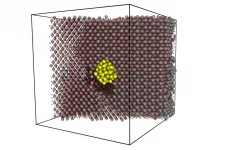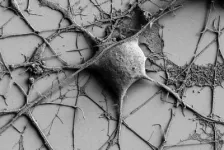Scientists find explanation for abnormally fast release of gas from nuclear fuel
2021-03-29
(Press-News.org) Scientists at MIPT have found a possible explanation for the anomalously fast release of gas from nuclear fuel. Supercomputer simulations have uncovered an unexpected mechanism for accelerating the escape of gas bubbles from the uranium dioxide crystal matrix to the surface. The result points the way to eliminate the paradoxical discrepancy of several orders of magnitude between existing theoretical models and experimental results. The paper was published in the Journal of Nuclear Materials.
The diffusion of gas bubbles during reactor operation is one of the important topics in nuclear power relating to radiation safety. Bubbles of gaseous fission products (mainly xenon), accumulating in the fuel, affect many of its properties. Therefore, it is important, in the design and operation of reactors, to know how fast the gas escapes from the fuel.
Despite the active work of various scientific groups in this field, there is still no complete understanding of the mechanisms of diffusion of gases in fuels. The recent series of works by French researchers is a striking evidence of this fact. The results shown by their proposed model are dozens of times lower than those measured in special experiments. "The very fact that such contradictory results and, in fact, unworkable theory have been published demonstrates, on the one hand, the scientific community's great interest in this problem and, on the other, the need to find fundamentally new physical mechanisms of ultrafast diffusion," says MIPT professor Vladimir Stegailov.
The MIPT scientists led by Vladimir Stegailov were able to simulate the diffusion of xenon nanobubbles in uranium dioxide over an atomic-scale time period of up to three microseconds (three billion integration steps). This was made possible by the optimal use of supercomputer power and modern codes. Such record-breaking molecular dynamics calculations have enabled direct observation of the Brownian motion of the bubble and discovery of a fundamentally new diffusion mechanism.
It was thought previously that the higher the gas concentration the slower the diffusion, as the gas interferes with the movement of the dioxide on the bubble's surface . The authors showed that upon reaching a certain concentration the gas pushes the atoms of the crystal lattice to inter-nodal positions.
"By accumulating, the inter-nodal atoms form clusters that move rapidly around the bubble. The bubble and the cluster periodically push each other and thus move significantly faster than the bubble on its own. Thus appears a new effect - acceleration of diffusion by gas", explains Alexander Antropov, a postgraduate student at FEFM (Phystech School of Electronics, Photonics and Molecular Physics at MIPT) and one of the authors of the study. The discovered effect will help explain the discrepancy between theory and experiment.
INFORMATION:
The work was performed at the Laboratory of Supercomputing Methods in Condensed Matter Physics, MIPT. The research in the Laboratory is based on combining methods of quantum and classical mechanics, statistical physics and kinetics with computational technologies. The use of state-of-the-art supercomputers and continuous improvement of numerical methods are very important to ensure high accuracy of calculations. However, modelling is just a tool that is useful only in conjunction with theoretical understanding of the nature of the processes taking place. This work is an example of how theory, armed with the most modern computational tools, makes it possible to find unexpected new phenomena "hidden" in the details of the microscopic structure of materials.
[Attachments] See images for this press release:

ELSE PRESS RELEASES FROM THIS DATE:
2021-03-29
Researchers at the University of Southampton have developed a new way of using nanomaterials to identify and enrich skeletal stem cells - a discovery which could eventually lead to new treatments for major bone fractures and the repair of lost or damaged bone.
Working together, a team of physicists, chemists and tissue engineering experts used specially designed gold nanoparticles to 'seek out' specific human bone stem cells - creating a fluorescent glow to reveal their presence among other types of cells and allow them to be isolated or 'enriched'.
The researchers concluded their new technique is simpler and quicker than other methods and up to 50-500 times more effective at enriching stem cells.
The study, led by Professor ...
2021-03-29
The vast majority of the world's largest meat and dairy companies have not made an explicit commitment to achieving net-zero emissions by 2050, finds a new analysis by researchers at New York University.
The study, which appears in the journal Climatic Change, examines the climate impacts of the biggest 35 largest meat and dairy companies around the globe as well as their influence in shaping political responses to climate change.
It is the first peer-reviewed study to assess climate responsibilities of the largest meat and dairy companies.
"Large meat and dairy companies are not doing enough to tackle climate change, and countries are not doing enough in terms of holding them accountable," says Jennifer ...
2021-03-29
Research into the flower preferences of pollinating moths may have delivered a vital clue to the simple factors needed for the emergence of new species.
Strong coevolutionary relationships between plants and animal pollinators have long been recognised as a potential driver of high rates of speciation in the 275,000 extant flowering plants.
Shifts between pollinators, such as bumblebees, hummingbirds, hawkmoths and bats, often coincide with plant speciation events.
Each of these pollinator "guilds" is attracted by a different set of floral traits such as colour, patterns, scent, shape, and nectar reward, collectively known as a pollination ...
2021-03-29
UNIVERSITY PARK, Pa. -- Why do some people with cold sores around their lips experience painful lesions, while others have no symptoms at all, yet still spread the virus? A new study conducted at Penn State finds that these differences could be due to variations in the way certain strains of herpes simplex (HSV-1) -- the virus that causes cold sores, as well as genital herpes -- activate gene expression in neurons.
"HSV-1 occurs in more than half the global population," said Moriah Szpara, associate professor of biology and biochemistry and molecular biology. "Not only does it cause recurrent problems, such as cold sores ...
2021-03-29
Transition metal perovskites oxides exhibit several desirable properties, including high-temperature superconductivity and electrocatalysis. Now, scientists at Tokyo Institute of Technology explore the structure and properties of a perovskite oxide, PbFeO3, in anticipation of the unusual charge distribution and exotic magnetic transitions displayed by such systems. They report two of the magnetic transitions, with a distinctive transition above room temperature and look into its causes, opening doors to potential applications in realizing new spintronic devices.
The advent of electronics has revolutionized our lives to an extent where it is impossible to imagine going about our day without relying on an electronic device in some form. What is even more remarkable, ...
2021-03-29
In a new publication from Cardiovascular Innovations and Applications; DOI https://doi.org/10.15212/CVIA.2021.0008, Zeyi Cheng, Miaomiao Qi, Chengyuan Zhang and Yanxia Mao from Sichuan University, Sichuan, China, Second Hospital of Lanzhou University, Lanzhou, China and The Second Medical School of Lanzhou University, Lanzhou, China consider myocardial fibrosis in the pathogenesis, diagnosis, and treatment of hypertrophic cardiomyopathy.
The authors review the application of myocardial fibrosis in the diagnosis and treatment of HCM, focusing on research progress and the application ...
2021-03-29
In a new publication from Cardiovascular Innovations and Applications; DOI https://doi.org/10.15212/CVIA.2021.0007, Sharen Lee and Gary Tse from Laboratory of Cardiovascular Physiology, Hong Kong, HKG, China, Second Hospital of Tianjin Medical University, Tianjin, China and Xiamen Cardiovascular Hospital, Xiamen, China consider a case of atezolizumab-induced autoimmune diabetes mellitus presenting with diabetic ketoacidosis.
Atezolizumab, an immune checkpoint inhibitor, is a humanized monoclonal, anti-programmed death ligand 1 (PD-L1) antibody used for the treatment of metastatic urothelial carcinoma that has progressed after chemotherapy. PD-L1 inhibitors can induce type 1 diabetes, and patients can present with diabetic ketoacidosis. ...
2021-03-29
In a new publication from Cardiovascular Innovations and Applications; DOI https://doi.org/10.15212/CVIA.2021.0006, Li Jingxiu, Zhang Fujun, Wei Xijin and Peng Ding from Anhui Provincial Hospital, Hefei, China, Chizhou Second People's Hospital, Chizhou, China, The Affiliated Hospital of Shandong University of TCM, Jinan, China and The Sixth Affiliated Hospital of Guangzhou Medical University, Qingyuan, China consider using three-dimensional Lorenz Scatter Plots to detect patients with atrioventricular node double path caused by interpolated ventricular premature systoles.
A series of related electrophysiology ...
2021-03-29
In a new publication from Cardiovascular Innovations and Applications; DOI https://doi.org/10.15212/CVIA.2021.0005, Nikhil H. Shah, Steven J. Ross, Steve A. Noutong Njapo, Justin Merritt, Andrew Kolarich, Michael Kaufmann, William M. Miles, David E. Winchester, Thomas A. Burkart, and Matthew McKillop from UF Division of Cardiovascular Medicine, Gainesville, FL, USA, UVA Division of Cardiovascular Medicine, Charlottesville, VA, USA, The Johns Hopkins Hospital Department of Radiology, Baltimore, MD, USA, The Heart Center, Huntsville, AL, USA, Intermountain Medical Center, St. George, UT, USA and Carolina Cardiology Consultants, Greenville, SC, USA consider appropriate use of implantable ...
2021-03-29
In a new publication from Cardiovascular Innovations and Applications; DOI https://doi.org/10.15212/CVIA.2021.0001, Zesen Han, Lihong Lai, Zhaokun Pu and Lan Yang from The People's Hospital of Hua County, Henan, China and Henan University of Science and Technology, Henan, China consider the use of nomograms to predict patients with obstructive coronary artery disease.
The authors developed and validated clinical prediction models for the development of a nomogram to estimate the probability of patients having coronary artery disease (CAD).
An individualized clinical prediction model for patients with CAD allowed an accurate estimation in Chinese populations. The Akaike information criterion is a better method in screening risk factors. The ...
LAST 30 PRESS RELEASES:
[Press-News.org] Scientists find explanation for abnormally fast release of gas from nuclear fuel



